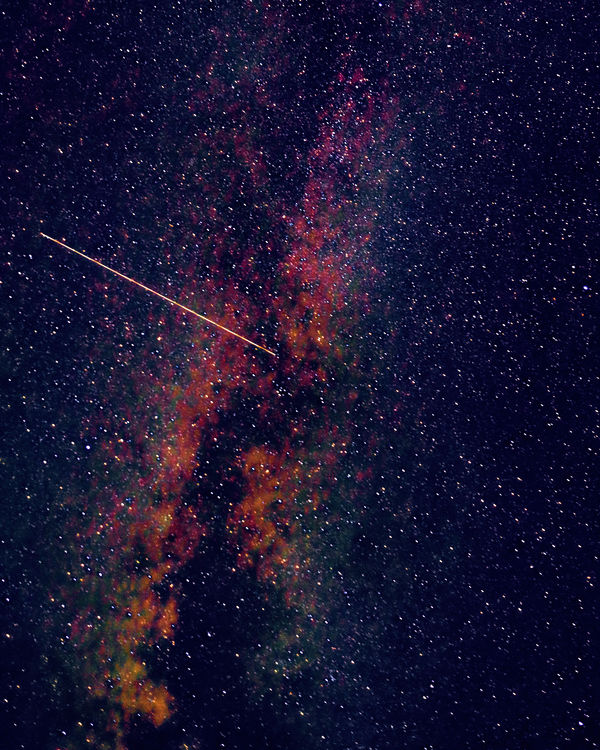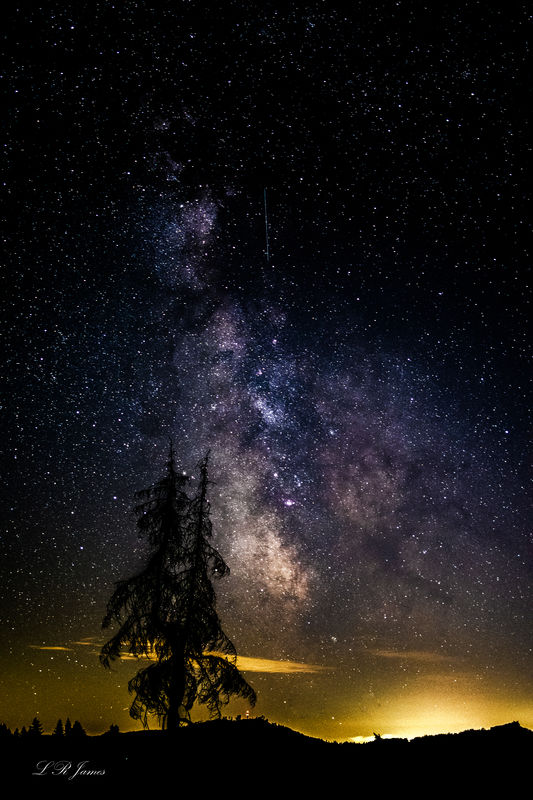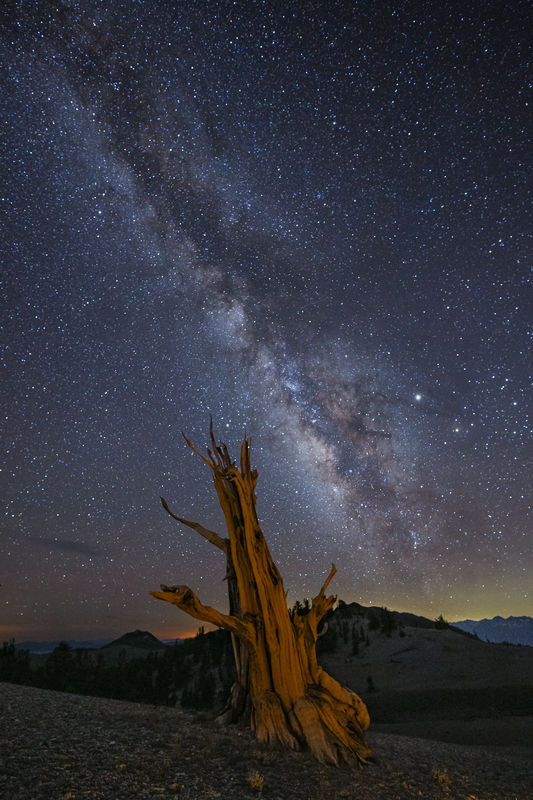Milky Way Attempt
Sep 19, 2019 21:41:30 #
Very interesting information. I live on Maui and have a 2 mile high mountain (Haleakala Crater) that I'm going to try and take some photos of the milky way in the very near future. Mahalo for all of the posts.
Sep 19, 2019 22:21:41 #
JoAnneK01 wrote:
Very interesting information. I live on Maui and have a 2 mile high mountain (Haleakala Crater) that I'm going to try and take some photos of the milky way in the very near future. Mahalo for all of the posts.
I drove to the top for astro one time, but pressure was too low and there was no much moisture, I was probably in thick clouds even though I drove through several layers starting around 4k' going up. I like the clean air around 5k to 6k elevation above all the dust and salt air, I bought a lens warmer to prevent fogging but haven't tried it yet. another good spot is LaPeruse or Kanaio, the lights from the Big Island, invisible to the naked eye, show up under the milky-way in the long exposures. From Makena side you can line up Kahoolawe with the milky-way and get a little reflection on the ocean. I'm planning on going this Sunday.
Sep 19, 2019 22:49:31 #
pilot64
Loc: Atlanta, GA
Light pollution is your biggest enemy. You want to be very dark, late PM or early AM if possible depending on time of new moon. Best time would be 12 AM-4AM if possible. Use The Photographer's Ephemeris (TPE) to determine best times. Location should be as dark as possible- no lights around. Two places in North Georgia I can attest to: Wayah Bald Tower (west of Franklin NC - google if for directions. elevation 5400') and Cowee Mounain Overlook on Blue Ridge Parkway (mile marker 431 - elevation 5950'). Both are accessible by auto although Wayah is an interesting drive through the woods. Everybody posting before gave you the camera settings already. ISO 2500-3500, time 14-25 seconds, wide open aperature (f 1.4-2.8). The wider the aperature, the longer the time and the better the result. Only thing left is to pray for good weather. Spent Sept 2nd (last new moon) at Wayah Bald and got nothing but clouds!! Very frustrating.....
Sep 19, 2019 23:41:45 #
Photo Pills is a wonderful tool. It will locate the Galactic center of the Milky Way for you, any place on earth and on any date. The Galactic center is not visible for about three months out of the year. It will give you the time and relationship of the sun and the moon on any date.
probably the hardest thing to learn is focus in the dark. TURN OFF auto focus. find the brightest star in the sky and find it on live view, digitally zoom in as far as you can and make that star the smallest point of light that you can. you will now be in focus. F stop wide open, don't be afraid to use a high ISO. The camera that you use will make a difference so you have to try several ISO settings. The higher the ISO the more digital noise. This photo was shot with ISO 5000. Personally I would never go over 20 seconds. this photo is 15 seconds. anything over that you will get star trails.
You can see the Milky Way if the conditions are dark enough but the camera is much more light sensitive than your eyes. Your photo will look like it was taken during the day out of the camera so it will have to be darkened in post. The reason for the bright exposure is to get more stars.
It took me three years of trying before I could get it right but then I guess I am slow
Good Luck
Larry James
probably the hardest thing to learn is focus in the dark. TURN OFF auto focus. find the brightest star in the sky and find it on live view, digitally zoom in as far as you can and make that star the smallest point of light that you can. you will now be in focus. F stop wide open, don't be afraid to use a high ISO. The camera that you use will make a difference so you have to try several ISO settings. The higher the ISO the more digital noise. This photo was shot with ISO 5000. Personally I would never go over 20 seconds. this photo is 15 seconds. anything over that you will get star trails.
You can see the Milky Way if the conditions are dark enough but the camera is much more light sensitive than your eyes. Your photo will look like it was taken during the day out of the camera so it will have to be darkened in post. The reason for the bright exposure is to get more stars.
It took me three years of trying before I could get it right but then I guess I am slow
Good Luck
Larry James
Sep 19, 2019 23:59:58 #
jayluber
Loc: Phoenix, AZ
As an artist you have to decide on how illuminated you want your foreground and what you want the MW to look like. Neither is right or wrong - you're the artist. I like my foreground illuminated and the sky to look a little blue and the MW more of a natural look. Some like the silhouette look like Larry's photo. It's all just personal preference.
Sep 20, 2019 00:05:14 #
jayluber
Loc: Phoenix, AZ
And let me add that you better get there early this time of year in GA. The core is setting at 8PM and by 9 it will be a bit late for good MW photos. It will be just south of West right between Saturn and Jupiter.
Sep 20, 2019 00:10:36 #
Sep 20, 2019 06:21:17 #
jayluber wrote:
Here's one I took last month to contrast the different styles.

Sep 20, 2019 09:38:34 #
juan_uy
Loc: Uruguay
jayluber wrote:
Here's one I took last month to contrast the different styles.
Both pictures do share part of their style, the greatness style

Sep 20, 2019 11:49:52 #
Sark17 wrote:
Hello! I put the New Moon on my calendar last week... (show quote)
Just recently came back from the Grand Canyon and did a lot of night time shots. I also have the EOS-R and had a great time with it there. I love the feedback on this site, it was very helpful in the time I had.
One of the things I didn't see in your post was where you are. The largest problem I have with where I am is all the light pollution. Look at a dark sky map to find a good place to go. The moon is also a major source of light pollution so lean how to use PhotoPills to find the proper time to go.
Couple of quick notes. I have the 24-70 F4 L lens. On manual focus, zoom in to a star you can see. Turn your focus to infinity. Back it off slightly until the dot is the smallest, that is when you're in focus. I saw this in a number of Youtube videos on shooting the milky way.
Also as to ISO, don't be afraid to push it to 5000-6000 or even more. I took the attached with a 30 second exposure at ISO 6000 and captured the shooting star while at Malden Point in the Canyon. I think I went too long, you can see there the start of star trails. It was a first for me so I was happy having the experience. I love the images I'm getting from the EOS-R and this one is no exception. I think the noise is incredibly low at a 6000 ISO.
Have fun, there are a lot of knowledgeable folks here to help, and perhaps look at Fro Knows Photo on Youtube. He does a video on shooting the milky way.
Dave

Sep 20, 2019 11:52:07 #
MauiMoto wrote:
And bring a dimmable headlamp, preferably red.
But don't forget to turn it off.
But don't forget to turn it off.
Beautiful shot.
If you want to reply, then register here. Registration is free and your account is created instantly, so you can post right away.





